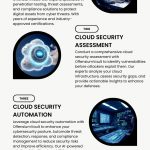Understanding VAPT Testing: Strengthening Cybersecurity for Businesses
With the rise in cyber threats, businesses must adopt proactive security measures to protect their data, systems, and customers. One of the most effective ways to identify and mitigate security vulnerabilities is through VAPT Testing, also known as Vulnerability Assessment and Penetration Testing.
VAPT testing is a comprehensive security assessment approach that helps organizations detect weaknesses in their IT infrastructure and applications before cybercriminals can exploit them. This process ensures that businesses can enhance their security posture and protect their assets from cyber-attacks.
What is VAPT Testing?
Vulnerability Assessment and Penetration Testing (VAPT) is a two-step security evaluation process that involves:
Vulnerability Assessment (VA): Identifies potential security weaknesses in a system, application, or network. It provides a comprehensive report on vulnerabilities and their severity.
Penetration Testing (PT): Simulates real-world cyber-attacks to determine whether the identified vulnerabilities can be exploited by hackers.
By combining these two methodologies, organizations can gain a deeper understanding of their security risks and take proactive steps to mitigate them.
Why is VAPT Testing Important?
Cybersecurity threats are becoming increasingly sophisticated, and businesses that fail to address security vulnerabilities may suffer severe consequences, including data breaches, financial losses, and reputational damage. Here’s why VAPT testing is crucial:
Identifies Security Weaknesses: VAPT testing uncovers vulnerabilities that may otherwise go unnoticed.
Prevents Data Breaches: Helps organizations address security gaps before cybercriminals exploit them.
Enhances Regulatory Compliance: Many industries require VAPT testing to meet legal and regulatory cybersecurity standards.
Protects Business Reputation: Preventing security incidents safeguards a company’s reputation and builds customer trust.
Ensures Business Continuity: By securing systems and applications, businesses can avoid disruptions caused by cyber-attacks.
Key Components of Vulnerability Assessment and Penetration Testing1. Vulnerability Assessment (VA)
This phase involves scanning IT systems, applications, and networks for potential security vulnerabilities. Common tasks in this phase include:
Automated vulnerability scanning using security tools.
Identifying security misconfigurations.
Analyzing outdated software or unpatched systems.
Reporting and categorizing vulnerabilities based on severity.
2. Penetration Testing (PT)
In this phase, cybersecurity specialists simulate real-world attacks to exploit vulnerabilities found during the assessment. The penetration testing process involves:
Conducting ethical hacking to test security defenses.
Attempting to gain unauthorized access to sensitive data.
Identifying weaknesses that could lead to data breaches.
Providing recommendations to remediate exploited vulnerabilities.
Types of VAPT Testing
Depending on an organization’s security needs, different types of VAPT testing can be conducted:
Network VAPT: Evaluates security vulnerabilities in network infrastructure, including servers, routers, and firewalls.
Web Application VAPT: Identifies security risks in websites and web applications, including SQL injection and cross-site scripting (XSS).
Mobile Application VAPT: Assesses vulnerabilities in mobile applications to protect user data and privacy.
Cloud Security VAPT: Examines cloud-based infrastructure for security flaws and compliance issues.
IoT VAPT: Evaluates security risks in Internet of Things (IoT) devices and networks.
VAPT Testing Process
To effectively assess cybersecurity risks, VAPT testing follows a structured process:
Planning & Scope Definition: Define the scope of testing, including target systems, applications, and testing methodologies.
Vulnerability Assessment: Scan and identify security vulnerabilities using automated and manual techniques.
Penetration Testing: Simulate real-world cyber-attacks to test system defenses.
Analysis & Reporting: Provide a detailed report with identified vulnerabilities, their impact, and remediation recommendations.
Remediation & Retesting: Implement security fixes and conduct follow-up testing to ensure vulnerabilities are resolved.
Tools Used in VAPT Testing
Security experts utilize various tools to perform VAPT testing, including:
Nmap: Network scanning tool to detect open ports and vulnerabilities.
Metasploit: A penetration testing framework used to exploit security weaknesses.
Burp Suite: A web application security testing tool for identifying vulnerabilities.
Nikto: A web server scanner that detects potential security issues.
OWASP ZAP: A widely used tool for testing web application security.
Choosing the Right VAPT Testing Provider
For effective security assessments, businesses should collaborate with experienced cybersecurity firms specializing in VAPT testing. When choosing a provider, consider the following factors:
Expertise & Certifications: Ensure the security team holds relevant certifications (e.g., CEH, CISSP, OSCP).
Customized Security Solutions: The provider should offer tailored security assessments based on business needs.
Comprehensive Reporting: The final report should include detailed findings and actionable recommendations.
Industry Experience: Look for a provider with experience in your industry’s cybersecurity requirements.
Conclusion
VAPT testing is an essential cybersecurity measure that helps businesses identify and mitigate vulnerabilities before they are exploited by hackers. By implementing Vulnerability Assessment and Penetration Testing, organizations can strengthen their security posture, comply with regulatory requirements, and protect their valuable data from cyber threats.
Partnering with a reliable cybersecurity firm ensures that businesses receive professional VAPT testing services tailored to their specific security needs. Investing in cybersecurity today helps businesses stay protected against evolving cyber threats in the future.































































